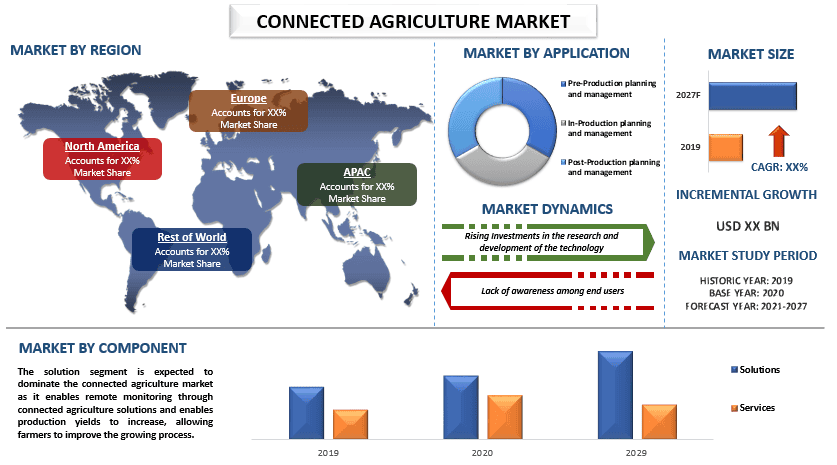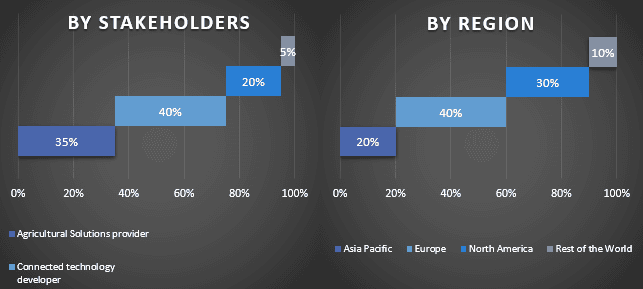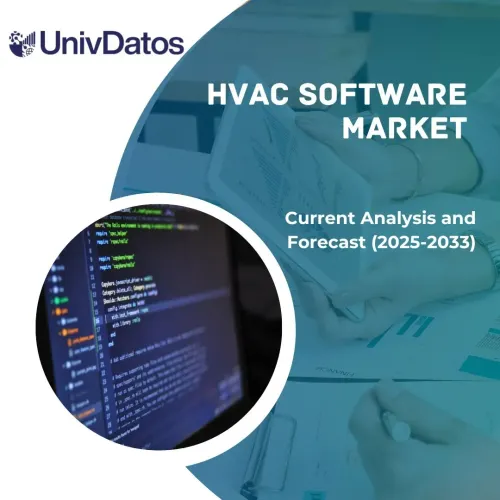- Strona główna
- O nas
- Branża
- Usługi
- Czytanie
- Kontakt
Połączony Rynek Rolnictwa: Aktualna Analiza i Prognoza (2021-2027)
Nacisk na Komponent (Rozwiązania, Usługi; Aplikacja (Planowanie i Zarządzanie Przedprodukcją, Planowanie i Zarządzanie Produkcją, Planowanie i Zarządzanie Poprodukcją); Region/ Kraj

Oczekuje się, że rynek Connected Agriculture odnotuje CAGR na poziomie około 20% w okresie 2021-2027. Connected agriculture definiuje się jako wykorzystanie zaawansowanych rozwiązań i usług technologicznych w celu ulepszania, zarządzania i kontrolowania przedprodukcyjnych, produkcyjnych i poprodukcyjnych działań rolniczych. Technologie te zapewniają odpowiednie umiejętności i wiele przydatnych technik, takich jak prawidłowe wykorzystanie nasion i nawozów, produkcja rolna, prognozowanie pogody, transport, przechowywanie, przetwarzanie żywności itp. Ponadto rosnący popyt na rozwiązania oparte na Agri-mobile w połączeniu z dostawcami usług telekomunikacyjnych koncentrującymi się na oferowaniu rozwiązań z zakresu connected agriculture w celu dostarczania danych w czasie rzeczywistym klientom końcowym ma dodatkowo wspierać przyjęcie rozwiązań z zakresu connected agriculture przez rynek. Na popyt na connected agriculture wpływa również rosnące zapotrzebowanie na zaawansowane rozwiązania rolnicze w celu maksymalizacji produkcji roślinnej przy minimalnych zasobach, takich jak woda, nawozy i nasiona. Ponadto wdrożenie różnych rozwiązań z zakresu connected agriculture pomogło rolnikom w lepszym zarządzaniu czasem i uprawami.
Do głównych firm na rynku należą Microsoft Corporation, IBM Corporation, AG Leader Technology, Cisco Systems Inc., AT&T, Accenture PLC, Orange Business Services, SAP SE, Epicor Software Corporation i Syspro Technologies.
Informacje zawarte w raporcie
„Spośród komponentów, kategoria rozwiązań stanowiła większościowy udział w rynku w 2020 r.”
Na podstawie komponentu rynek jest podzielony na rozwiązania i usługi. Oczekuje się, że segment rozwiązań zdominuje rynek connected agriculture, ponieważ umożliwia zdalne monitorowanie za pośrednictwem rozwiązań connected agriculture i umożliwia dalszy wzrost wydajności produkcji, co pozwala rolnikom na ulepszenie procesu uprawy. Connected agriculture pomaga rolnikom zwiększyć produkcję i ulepszyć proces uprawy. Pomaga im również poprawić jakość upraw, a także pomaga rolnikom w przeprowadzaniu transakcji finansowych.
„Spośród zastosowań oczekuje się, że planowanie i zarządzanie produkcją odnotują najwyższy CAGR w okresie prognozy”
Ze względu na zastosowanie rynek jest podzielony na planowanie i zarządzanie przedprodukcją, planowanie i zarządzanie produkcją oraz planowanie i zarządzanie poprodukcją. Oczekuje się, że segment zarządzania produkcją będzie posiadał większość udziałów w rynku. Planowanie jest ważnym czynnikiem ze względu na nieodłączną niepewność związaną z pogodą, ryzykiem finansowym. Segment zarządzania produkcją w connected agriculture pomaga w produkcji produktów dobrej jakości i wyższym tempie produkcji. Planowanie i zarządzanie produkcją umożliwia rolnikom dostęp do danych w czasie rzeczywistym, aby podejmować proaktywne decyzje, które pomagają w produkcji efektywnych plonów.
„Oczekuje się, że Ameryka Północna odnotuje znaczny wzrost w okresie prognozy”
Oczekuje się, że Ameryka Północna zdominuje rynek connected agriculture i utrzyma tę pozycję w okresie prognozy. Głównym powodem wzrostu jest obecność dużej liczby dostawców rozwiązań connected agriculture. Ponadto ciągły postęp technologiczny i obniżenie cen sprzętu rolniczego to niektóre z czynników wzrostu dla rynku connected agriculture w Ameryce Północnej. Rolnicy, hodowcy i handlowcy w Ameryce Północnej zmierzają w kierunku cyfryzacji poprzez wdrażanie rozwiązań rolniczych, które wykorzystują różne zaawansowane technologie, takie jak IoT, AI big data, analiza danych i analiza predykcyjna. Ponadto w krajach takich jak USA i Kanada podjęto liczne inicjatywy rządowe, aby zachęcić do wdrażania zaawansowanych technologii rolniczych, co dodatkowo podniosło wzrost rynku connected agriculture w Ameryce Północnej.
Powody, dla których warto kupić ten raport:
- Badanie obejmuje analizę wielkości rynku i prognozowania, zatwierdzoną przez uwierzytelnionych kluczowych ekspertów branżowych.
- Raport przedstawia szybki przegląd ogólnej wydajności branży na pierwszy rzut oka.
- Raport obejmuje dogłębną analizę wybitnych konkurentów z branży, ze szczególnym uwzględnieniem kluczowych danych finansowych, portfeli produktów, strategii ekspansji i ostatnich wydarzeń.
- Szczegółowe badanie czynników napędzających, ograniczeń, kluczowych trendów i możliwości występujących w branży.
- Badanie kompleksowo obejmuje rynek w różnych segmentach.
- Dogłębna analiza branży na poziomie regionalnym.
Opcje dostosowania:
Rynek connected Agriculture można dodatkowo dostosować do wymagań lub dowolnego innego segmentu rynku. Poza tym UMI rozumie, że możesz mieć własne potrzeby biznesowe, dlatego skontaktuj się z nami, aby uzyskać raport, który w pełni odpowiada Twoim wymaganiom.
Spis treści
Metodologia badań rynku rolnictwa połączonego (2021-2027)
Analiza historycznego rynku, szacowanie obecnego rynku i prognozowanie przyszłego rynku rolnictwa połączonego to trzy główne kroki podjęte w celu stworzenia i analizy adopcji rolnictwa połączonego w głównych regionach na całym świecie. Przeprowadzono wyczerpujące badania wtórne w celu zebrania historycznych danych rynkowych i oszacowania obecnej wielkości rynku. Po drugie, aby zweryfikować te spostrzeżenia, wzięto pod uwagę liczne ustalenia i założenia. Ponadto przeprowadzono wyczerpujące wywiady pierwotne z ekspertami branżowymi w całym łańcuchu wartości rynku rolnictwa połączonego. Po założeniu i walidacji danych rynkowych poprzez wywiady pierwotne zastosowaliśmy podejście top-down/bottom-up do prognozowania całkowitej wielkości rynku. Następnie przyjęto metody podziału rynku i triangulacji danych w celu oszacowania i analizy wielkości rynku segmentów i podsegmentów branży, której to dotyczy. Szczegółowa metodologia została wyjaśniona poniżej:
Analiza historycznej wielkości rynku
Krok 1: Dogłębne badanie źródeł wtórnych:
Przeprowadzono szczegółowe badanie wtórne w celu uzyskania historycznej wielkości rynku rolnictwa połączonego poprzez wewnętrzne źródła firmy, takie jak raporty roczne i sprawozdania finansowe, prezentacje wyników, komunikaty prasowe itp., oraz zewnętrzne źródła, w tym czasopisma, wiadomości i artykuły, publikacje rządowe, publikacje konkurencji, raporty sektorowe, bazy danych stron trzecich i inne wiarygodne publikacje.
Krok 2: Segmentacja rynku:
Po uzyskaniu historycznej wielkości rynku rolnictwa połączonego przeprowadziliśmy szczegółową analizę wtórną w celu zebrania historycznych spostrzeżeń rynkowych i udziałów dla różnych segmentów i podsegmentów w głównych regionach. Główne segmenty uwzględnione w raporcie to komponent i zastosowanie. Przeprowadzono dalsze analizy na poziomie krajowym, aby ocenić ogólne przyjęcie modeli testowania w danym regionie.
Krok 3: Analiza czynnikowa:
Po uzyskaniu historycznej wielkości rynku różnych segmentów i podsegmentów przeprowadziliśmy szczegółową analizę czynnikową w celu oszacowania obecnej wielkości rynku rolnictwa połączonego. Ponadto przeprowadziliśmy analizę czynnikową przy użyciu zmiennych zależnych i niezależnych, takich jak różne komponenty i zastosowania rolnictwa połączonego. Przeprowadzono dokładną analizę scenariuszy po stronie popytu i podaży, biorąc pod uwagę najważniejsze partnerstwa, fuzje i przejęcia, ekspansję biznesową i premiery produktów w sektorze rynku rolnictwa połączonego na całym świecie.
Szacunkowa obecna wielkość rynku i prognoza
Obecna wielkość rynku: Na podstawie praktycznych spostrzeżeń z powyższych 3 kroków doszliśmy do obecnej wielkości rynku, kluczowych graczy na rynku rolnictwa połączonego i udziałów w rynku poszczególnych segmentów. Wszystkie wymagane udziały procentowe i podziały rynku zostały określone przy użyciu wspomnianego powyżej podejścia wtórnego i zweryfikowane za pomocą wywiadów pierwotnych.
Szacowanie i prognozowanie: Do oszacowania rynku i prognozy przypisano wagi różnym czynnikom, w tym czynnikom napędzającym i trendom, ograniczeniom i możliwościom dostępnym dla interesariuszy. Po przeanalizowaniu tych czynników zastosowano odpowiednie techniki prognozowania, tj. podejście top-down/bottom-up, aby dojść do prognozy rynkowej na temat 2027 roku dla różnych segmentów i podsegmentów na głównych rynkach na całym świecie. Metodologia badań przyjęta do oszacowania wielkości rynku obejmuje:
- Wielkość rynku branży pod względem przychodów (USD) i wskaźnik adopcji rynku rolnictwa połączonego na głównych rynkach krajowych
- Wszystkie udziały procentowe, podziały i rozbicia segmentów i podsegmentów rynku
- Kluczowi gracze na rynku rolnictwa połączonego pod względem oferowanych rozwiązań. Ponadto strategie wzrostu przyjęte przez tych graczy, aby konkurować na szybko rozwijającym się rynku
Walidacja wielkości rynku i udziału
Badania pierwotne: Przeprowadzono dogłębne wywiady z kluczowymi liderami opinii (KOL), w tym kadrą kierowniczą najwyższego szczebla (CXO/wiceprezesi, szef ds. sprzedaży, szef ds. marketingu, szef ds. operacyjnych i szef regionalny, szef krajowy itp.) w głównych regionach. Następnie podsumowano wyniki badań pierwotnych i przeprowadzono analizę statystyczną w celu udowodnienia postawionej hipotezy. Dane wejściowe z badań pierwotnych zostały połączone z wynikami badań wtórnych, przekształcając w ten sposób informacje w praktyczne spostrzeżenia.
Podział uczestników pierwotnych w różnych regionach

Inżynieria rynku
Zastosowano technikę triangulacji danych, aby ukończyć ogólne szacowanie rynku i dojść do precyzyjnych liczb statystycznych dla każdego segmentu i podsegmentu rynku rolnictwa połączonego. Dane zostały podzielone na kilka segmentów i podsegmentów po przestudiowaniu różnych parametrów i trendów w obszarach komponentów i zastosowań na rynku rolnictwa połączonego.
Główny cel badania rynku rolnictwa połączonego
W badaniu wskazano obecne i przyszłe trendy rynkowe na rynku rolnictwa połączonego. Inwestorzy mogą uzyskać strategiczne spostrzeżenia, na których mogą oprzeć swoje decyzje dotyczące inwestycji na podstawie analizy jakościowej i ilościowej przeprowadzonej w badaniu. Obecne i przyszłe trendy rynkowe określiły ogólną atrakcyjność rynku na poziomie regionalnym, zapewniając uczestnikom przemysłowym platformę do wykorzystania niewykorzystanego rynku, aby skorzystać z przewagi pioniera. Inne ilościowe cele badań obejmują:
- Analizę obecnej i prognozowanej wielkości rynku rolnictwa połączonego pod względem wartości (USD). Ponadto analizę obecnej i prognozowanej wielkości rynku różnych segmentów i podsegmentów
- Segmenty w badaniu obejmują obszary komponentów i zastosowań
- Definicję i analizę ram regulacyjnych dla branży rynku rolnictwa połączonego.
- Analizę łańcucha wartości związanego z obecnością różnych pośredników, wraz z analizą zachowań klientów i konkurencji w branży.
- Analizę obecnej i prognozowanej wielkości rynku rolnictwa połączonego dla głównego regionu.
- Główne kraje regionów badane w raporcie obejmują Azję i Pacyfik, Europę, Amerykę Północną i resztę świata.
- Profile firm na rynku rolnictwa połączonego i strategie wzrostu przyjęte przez uczestników rynku w celu utrzymania się na szybko rozwijającym się rynku
- Dogłębną analizę branży na poziomie regionalnym
Powiązane Raporty
Klienci, którzy kupili ten przedmiot, kupili również










